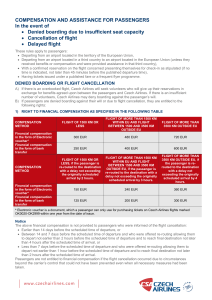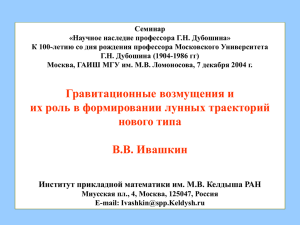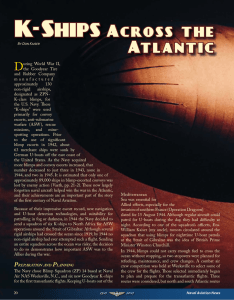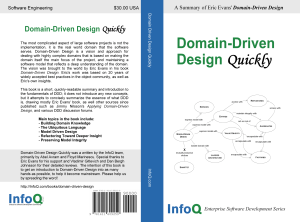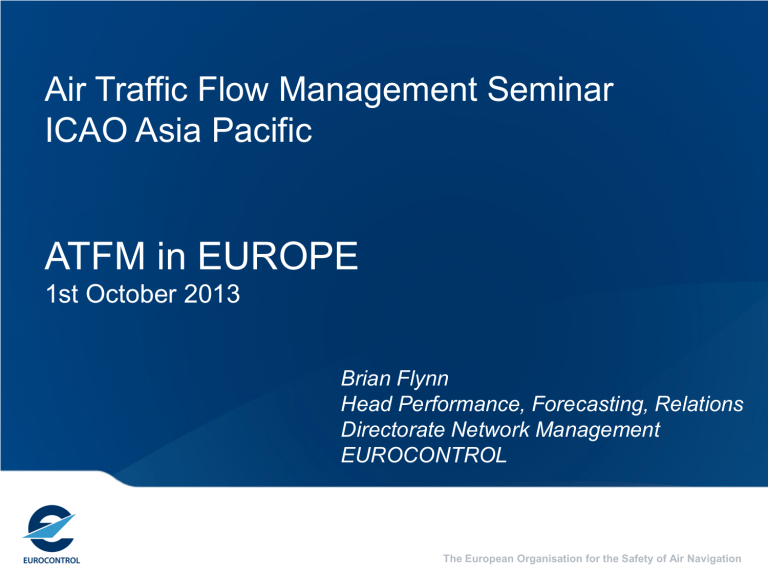
Air Traffic Flow Management Seminar ICAO Asia Pacific ATFM in EUROPE 1st October 2013 Brian Flynn Head Performance, Forecasting, Relations Directorate Network Management EUROCONTROL The European Organisation for the Safety of Air Navigation ATFM in Europe - 2013 • From ATFM to Network Management • Bridging the gap between ATFM and ATC, and between today and tomorrow (SESAR) • ATFM: A performance driven system, capacity, flight efficiency, cost effectiveness • Interoperability and global ATFM European Aviaton • 40 ANSPs, • A business of 9 bn EUR with some 57,000 staff and 16,900 are air traffic controllers. • 9, 5 million flights and on peak days, 33.000 flights. 2020 forecast 17 million flights yearly and 50,000 flights on busy days. • European airspace : 10,8 million km², 60 control centres- fragmentation of airspace. ATFM in Europe - 2013 • From ATFM to Network Management • Bridging the gap between ATFM and ATC, and between today and tomorrow (SESAR) • ATFM: A performance driven system, capacity, flight efficiency, cost effectiveness • Interoperability and global ATFM EU Aviation Policy • Single Market • The aviation market liberalised through measures adopted at EU level which covered air carrier licensing, market access and fares. • External Aviation • More coordinated EU external aviation policy • Single European Sky • Airspace congestion and strain on airport capacity. Single European Sky (SES), launched in 2004. A second package SES II, followed in 2009, greater emphasis on environment and cost efficiency. • SESAR • The technology required for the future Single Sky is provided through the air traffic management research programme SESAR, modernise infrastructure and raise efficiency by optimising capacity. Single European Sky – SES - ATM • Reform ATM in Europe. • de-fragment the European airspace, • reduce delays, • increase safety standards • increase flight efficiency to reduce the aviation environmental footprint • reduce costs related to service provision Single European Sky II • The Performance Scheme: EU-wide performance targets for each reporting period in areas of capacity, environment, safety and cost efficiency. • The Functional Airspace Blocks ; de-fragment the airspace and obtain the operational efficiency gains through such strategies as common procurement, training and optimisation of air traffic controllers (ATCs) resources. • The Network Manager ; centralised function at EU level to carry out the management of the ATM network functions (airspace design, flow management) and management of scarce resources(transponder code allocations,radio frequencies). • The Charging Regulation on the en-route charging system lays down a legal framework of transparent reporting of en-route charges and costs' components of the Member States. It also defines a legal basis for financing, through the charging system, of the "Common Projects" in the context of the deployment of SESAR. The Network Manager • 4 main functions : • Manage and operate ATFM. • Route Network Design • Central function for Frequency Allocation • Coordinate improvement of SSR Code Allocation, and • Provide support for Crisis Management. • In addition to the functions above, the Network Manager shall "contribute to the deployment of SESAR according to the European ATM Master Plan." Network Management Board, representatives of ANSPs, airspace users, the military, and airport operators. Strategic and Operational Plans for the Network. Subject to the provisions of the Performance Scheme and contributes to improvements in the 4 Key performance Areas, therein : Safety, Cost-Efficiency, Environment and Capacity. • • • ATFCM Structure in Europe One single Flow Management System over Europe 41 States 1750 Sectors & 64 enroute centres 1348 Aircraft Operators 450 Airports 61 FMPs Network Operations +4,000 connected end-users Peaks +33,000 Flights a day 10,000,000 Flights a year Network Operations Services ATFM : an integrated ATM system Air Traffic Flow & Capacity Management (ATFCM) Flight Plan Processing Airspace Data Management EAD & Aeronautical Information (EAB) From ATFM to Network Management ATFM Delay Flight Efficiency ATFCM Network Operations Capacity Capacity Emissions The Network Concept – ATM without borders • • • • • • • • • Consolidate operations across the network Identify critical areas Devise solutions independent of borders Detailed shared knowledge of operational situation Route network and Airspace design Centralised ATFCM function Data base of infrastructure and traffic demand Network crisis management Agreed plans – Strategy Plan, Performance Plan, Operations Plan • Performance monitoring, reporting and oversight Conclusions • A network management approach requires • Institutional and regulatory arrangements • Strong governance inclusive of all regulatory and operational stakeholders • Cooperative decision making processes in which decisions are made based on a constant interaction and consultation with Member States, operational stakeholders (ANSPs, airspace users and airports) and other actors • Clear performance objectives and targets for all parties including the Network Manager • Network Management can build the partnership to achieve long term performance (safety, capacity, environment and cost efficiency) ATFM in Europe - 2013 • From ATFM to Network Management • Bridging the gap between ATFM and ATC, and between today and tomorrow (SESAR) • ATFM: A performance driven system, capacity, flight efficiency, cost effectiveness • Interoperability and global ATFM Bridging the gap • SESAR will deliver around 2020. How do we manage 2013 to 2019? • Entry counts to Occupancy • STAM: Short term ATFM measures • CTOT (ground delay) to TTO/TTA • Predictability • Airport and network integration ATFM in Europe - 2013 • From ATFM to Network Management • Bridging the gap between ATFM and ATC, and between today and tomorrow (SESAR) • ATFM: A performance driven system, capacity, flight efficiency, cost effectiveness • Interoperability and global ATFM 2012 Capacity / delay - results ATFM delay (mins) per flight 2006-2014 • En-route ATFM delay per flight of 0.63 mins • 0.57 mins excl. disruption • Successful event coordination • Airport ATFM delay lowest level for years (0.48 minutes per flight) 2.25 2.00 1.75 1.50 1.25 1.00 0.75 0.50 0.25 AIRPORT 29000 28000 27000 26000 25000 24000 2006 2007 2008 2009 2010 2011 2012 2014 0.6 0.5 0.8504 0.9258 0.7535 0.6356 0.8558 0.6709 0.4837 EN-ROUTE 1.0624 1.2068 1.5881 0.9616 2.0238 1.1376 0.6299 Traffic 2013 26286 27676 27818 26103 26329 27146 26427 26153 26888 23000 Traffic • Achieved en-route delay interim target (0.7 mins) Delay • 6% network capacity increase Flight efficiency • Positive trend for both route extension indicators • Need to reduce the gap between the two • NM actions with airspace users to improve flight efficiency RTE-DES RTE-FPL 2012 2011 2010 2009 2008 5,5% 2007 Route Efficiency KPI per AIRAC cycle 1 0,9 5,0% 0,8 0,6 4,0% Gap to be reduced 0,5 0,4 3,5% 0,3 0,2 3,0% 0,1 2,5% 0 713 801 802 803 804 805 806 807 808 809 810 811 812 813 901 902 903 904 905 906 907 908 909 910 911 912 913 1001 1002 1003 1004 1005 1006 1007 1008 1009 1010 1011 1012 1013 1101 1102 1103 1104 1105 1106 1107 1108 1109 1110 1111 1112 1113 1201 1202 1203 1204 1205 1206 1207 1208 1209 1210 1211 1212 1213 Route Extension 0,7 4,5% AIRAC Flight efficiency evolution Progress on flight efficiency achievements RTE-DES 6% RTE-FPL 5% 6% 4% 5% 3% 3,53% 3,54% 3,45% 3,22% 3,04% 2,96% 2,86% 4,91% 5,03% 4,90% 4,91% 4,73% 4,64% 4,62% 4% 3% 2% 2007 2008 2009 2010 2011 2012 2013 2% 2007 Target 2013: +2.85% 2008 2009 2010 2011 2012 Target 2013: +4.4% 2013 Network Manager Added Value - NMPP • • • • • • • Managing planned network disruptions Delay sharing for benefit of network Reduce any individual AO delays > 30mins Mitigate WX delays Reduce ATFCM measures Target weekend delays Crisis and unplanned major disruptions management NM objectives 10% delay reduction attributable to NM efforts ATFM in Europe - 2013 • From ATFM to Network Management • Bridging the gap between ATFM and ATC, and between today and tomorrow (SESAR) • ATFM: A performance driven system, capacity, flight efficiency, cost effectiveness • Interoperability and global ATFM Interoperability and Global ATFM •ATFM and some aspects of capacity management cannot be restricted to the area of one State because of their far-reaching effects on the flow of air traffic elsewhere. (ICAO FASID Doc 7754) •Aviation is global, ATM is not! •Security •Natural Hazards APR (ACARS) FAA EFD Optimising Airport Operations Linking the airport and the network Network Operations Portal © EUROCONTROL2009 – Central Flow Management Unit • CONCLUSION: The ASTER should operate in partnership with the ATS providers and aircraft operators. It cannot be a directive organisation as the other partners have regulatory (safety and economic) regimes to live within, and different stakeholder/shareholder expectations.
